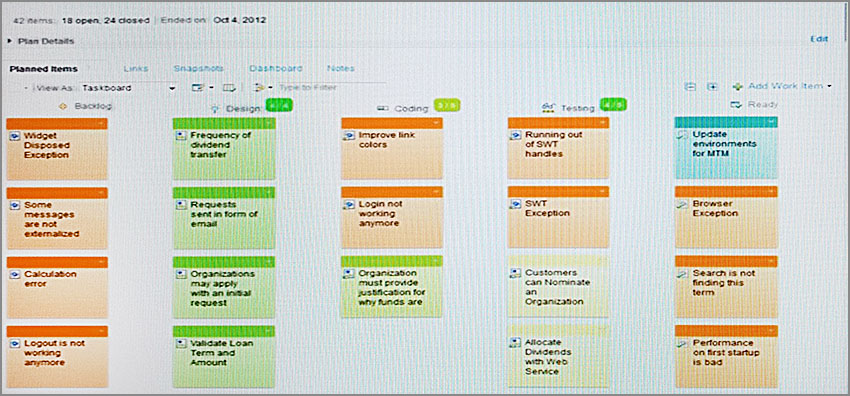Foundations of IBM DevOps V1 v7.0
Question 1
Software Defined Environments (SDE) display a number of different characteristics from traditional IT. What are two characteristics of a SDE? (Choose two.)
- A. managed by advanced programmed automation
- B. uses virtualization to manage IT
- C. leverages server, storage, and network silos
- D. managing virtual resources as you manage hardware
- E. managed with extensive manual process
Answer : AB
Explanation: References:
Question 2
If a client was referring to developing cloud native applications, what are two likely characteristics of the application? (Choose two.)
- A. stateful
- B. monolithic
- C. microservices
- D. tightly coupled
- E. stateless
Answer : AB
Question 3
After executing assessments and workshops, it has been determined that 80% of developments time is related to waiting for responses from various departments. What should the organization do to fix these bottlenecks?
- A. Create a global enablement plan. Once each professional has more expertise they will be able to do their job faster and improve the overall productivity.
- B. Automate the development and operation process with continuous delivery tools.
- C. Create highlyspecialized SWAT teams for requirements management, testing and deployment.
- D. Change to a dedicated cells approach, with self-sufficient teams composed of several skills.
Answer : B
Question 4
A retail company implemented several DevOps practices to improve time to market and to increase customer satisfaction. They realized several benefits like delivery time, quality of services and small release cycles. Even doing all those improvements, their customers are still very unsatisfied with their website.
Which DevOps practice should they focus on to understand the reasons the customers are not satisfied and to improve customer satisfaction?
- A. shift left requirements
- B. requirements management
- C. feedback management
- D. continuous feedback
Answer : C
Question 5
When long lived source control management (SCM) branches are merged, significant amounts of network can be required to resolve code conflicts. Which DevOps practice addresses this problem?
- A. continuous integration
- B. test-driven development
- C. A/B testing
- D. continuous deployment
Answer : B
Question 6
What is the method for managing knowledge work with an emphasis on just-in-time delivery while not overloading the team members?
- A. Scrum
- B. Kanban
- C. Kaizen
- D. Waterfall
Answer : B
Explanation: References:
Question 7
A company is creating a complex application with several Innovation Edge teams (using continuous delivery) and three Industrialized Core teams operating in an agile manner but with longer release cycles. They recognize that their delivery model has multi-speed characteristics.
What is the main benefit of automated release for multi-speed IT environments?
- A. It relieves release managers from the burden of using project plans.
- B. It reduces the effort to manage the release of multiple interdependent applications.
- C. It reduces reliance on manual processes including scripting.
- D. It reduces compilation, build, and build verification test times.
Answer : D
Question 8
Which two statements are true regarding DevOps value stream mapping to identify bottlenecks that need to be addressed in a DevOps adoption roadmap? (Choose two.)
- A. A DevOps toolchain has been identified and agreed upon.
- B. Organizationmaturity level regarding DevOps is realized.
- C. Improvement are prioritized.
- D. Release and iteration planning are organized.
- E. Business and IT goals are identified.
Answer : B,E
Question 9
Which DevOps method does the diagram below represent?

- A. Showcase
- B. Planning Poker
- C. Burn-Down and Burn-Up charts
- D. Kanban
Answer : B
Question 10
Which two activities are part of collaborative development practices? (Choose two.)
- A. contingency planning
- B. business planning
- C. continuous monitoring
- D. enable ongoing testing and verification of code
- E. software configuration management
Answer : CD
Question 11
What are three sub-components of incident management? (Choose three.)
- A. event correlation
- B. dashboards
- C. orchestration
- D. strategy
- E. root cause analysis
- F. notification
Answer : ABF
Explanation:
Referencehttps://www.ibm.com/devops/method/content/architecture/serviceManagementAr chitecture/
Question 12
Which DevOps principle describes code flowing through a consistent, automated sequence of stages where each stage tests the code from a different perspective?
- A. agile development
- B. automated build process
- C. continuous integration
- D. delivery pipeline
Answer : D
Explanation: References:
Question 13
What action does the IBM Bluemix Garage Method Learn phase recommend to continuously experiment?
- A. hold playbacks
- B. run A/B tests
- C. automate unit tests
- D. leverage IBM Design Thinking
Answer : B
Explanation: References:
Question 14
A developer works in a cloud environment with IBM Bluemix and needs to deploy new versions of code to production without any downtime in their application access. Which IBM offering would provide the required functionality?
- A. IBM Cloud Orchestrator
- B. IBM Active Deploy
- C. IBMBluemix DevOps Services
- D. IBM DevOps Insights
Answer : B
Explanation: References:
Question 15
Which concept in the Spotify Model is used to identify a collections of Squads within the same business area?
- A. Chapter
- B. Legion
- C. Tribe
- D. Guild
Answer : C
Explanation:
Reference http://www.full-stackagile.com/2016/02/14/team-organisation-squads-chapters- tribes-and-guilds/